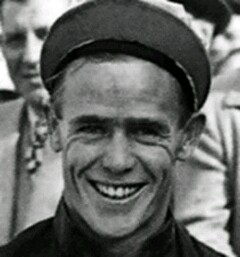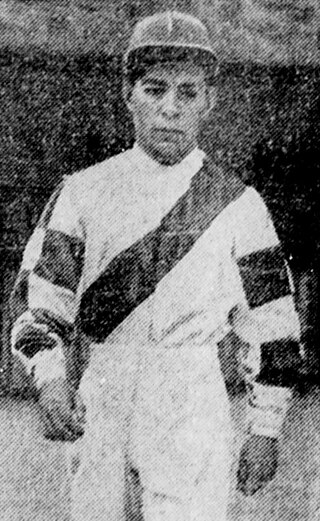
Citation was a champion American Thoroughbred racehorse who is the eighth winner of the American Triple Crown. He won 16 consecutive stakes races and was the first horse in history to win US$1 million.

Arlington Park was a horse race track in the Chicago suburb of Arlington Heights, Illinois. Called the Arlington Park Jockey Club during a period of its history, it was located adjacent to the Illinois Route 53 expressway and serviced by the Chicago and Northwestern Railroad.

Whirlaway was a champion American Thoroughbred racehorse who is the fifth winner of the American Triple Crown. He also won the Travers Stakes after his Triple Crown sweep to become the first and only horse to win all four races.
Hawthorne Race Course is a racetrack for horse racing in Stickney, Illinois, near Chicago.
Swaps was a California bred American thoroughbred racehorse. He won the Kentucky Derby in 1955 and was named United States Horse of the Year in the following year. He was known as the "California Comet," and occasionally with affection, due to his wins despite numerous injuries and treatments, the "California Cripple."
Coaltown (1945–1965) was an American Hall of Fame Champion Thoroughbred racehorse of whom The New York Times said "was probably the most underrated Thoroughbred of the 20th Century."

Albert Snider was a jockey in Thoroughbred racing who had success in his native Canada as well as the United States.

Balmoral Park is an equestrian facility located just south of Crete, Illinois, United States. It operated from 1926 to 2015 as a horse racing track. It reopened in 2017 as a horse show facility under the same name.
Steve Brooks was an American National Champion and Hall of Fame jockey. The son of a horse dealer, he was born in McCook, Nebraska. He began riding horses as a boy of ten and at age sixteen in 1938 won his first race at an accredited race track.

Conn N. McCreary was a United States Hall of Fame jockey and trainer in Thoroughbred horse racing who won four American Classic Races.
The Round Table Stakes was an American Thoroughbred horse race run on dirt and on turf forty-four times between 1961 and 2007. First run at Washington Park Race Track in Homewood, Illinois as the Round Table Handicap, in 1963 it was moved to Arlington Park racetrack in Arlington Heights. In 1985 a fire destroyed the track's grandstand and clubhouse and its races were hosted that year by Chicago's Hawthorne Race Course. A stakes race open to three-year-old horses, it was last contested on Polytrack synthetic dirt over a distance of one and one-eighth miles. From inception through 1968, it was a handicap race for horses age three and older.
Fred A. Smith was a Cuban American jockey in Thoroughbred horse racing best remembered for narrowly missing victory in the 1940 U.S. Triple Crown.
Market Wise was an American Champion Thoroughbred racehorse.
Wistful was an American Champion Thoroughbred racemare. The daughter of Sun Again and granddaughter of Sun Teddy is best remembered for wins in the Kentucky Oaks, the Coaching Club American Oaks, the Black-Eyed Susan Stakes.
General Duke was an American Thoroughbred racehorse who won the second running of the Belmont Stakes in 1868. A son of Lexington, he was bred by Robert A. Alexander in Kentucky. He raced as a two-year-old, winning twice, including a stakes race. As a three-year-old, he raced nine times, winning six races, including several stakes. His final racing record was 18 wins from 32 starts. He was later known as Judge Curtis, and after his racing career ended he was a breeding stallion in Canada before dying in Illinois in 1888. Three of his daughters won stakes races.
Gen. Duke (1954–1958) was an American Thoroughbred racehorse who won the 1957 Florida Derby.

Harry Bassett (1868–1878) was an American Thoroughbred racehorse, winner of the 1871 Belmont Stakes and an outstanding racehorse of the 19th century. He also won a number of other stakes races, and was named the Champion male of his age group in 1870, 1871 and 1872. He was retired to stud duties in New Jersey when his five-year racing career ended, having recorded 23 wins from 36 starts. Harry Bassett died in New Jersey in 1878 and was inducted into the United States Racing Hall of Fame in 2010.
Nadir was a Thoroughbred racehorse who was one of two colts voted the American Champion Two-Year-Old Colt of 1957. He was bred and raced by Bull Hancock's Claiborne Farm.
Rushaway was an American Thoroughbred racehorse whose enduring legacy was his two Derby wins on consecutive days in two different states. Owned and trained by Alfred Tarn, in both races, Rushaway was ridden by Tarn's son-in-law, the future National Museum of Racing and Hall of Fame inductee Johnny Longden. On Friday afternoon, May 22, 1936, Rushaway won the Illinois Derby at Aurora Downs in Aurora, Illinois. That night, Tarn shipped the three-year-old gelding three hundred miles south via express train to the Latonia Race Track in Latonia, Kentucky, where on Saturday afternoon he won the Latonia Derby. Rushaway's feat of endurance is still talked about more than eighty years later.
The Whirlaway Handicap is a discontinued Thoroughbred horse race run at Washington Park Race Track in Chicago, Illinois. The event was first held on August 21, 1946, and had its final running on August 16, 1952. Open to horses three years of age and older, the race on dirt was run as the Whirlaway Stakes from 1946 to 1951 and for 1952 as the Whirlaway Handicap.










